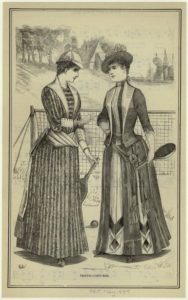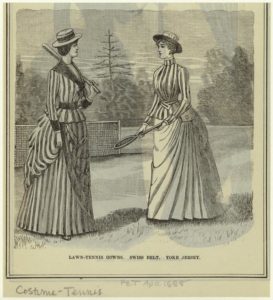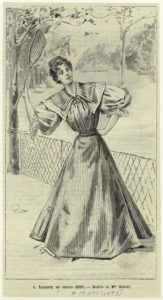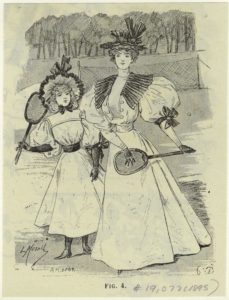Tennis, anyone? It seems ridiculous to us today to look at fashion plates from the Victorian era and realize that some of those huge, voluminous dresses with full bustles and flounces were meant to be tennis dresses. In the modern era, tennis players look like this:
So how do you get to Serena's nearly complete domination of the women's game for the last decade in a totally functional tennis dress (or skirt and top) from these ladies?

During the Victorian era an increasing number of women picked up a wooden racket and hit the courts (in full-length gowns of course). Women of the upper and middle classes began to take an interest in sport — croquet in the 1860s, tennis in the 1870s and 1880s, and the daring sport of cycling in the 1890s, according to Catroina M. Parratt in her article "Atheltic 'Womanhood:' Exploring Sources for Female Sport in Victorian and Edwardian England."
The growing popularity of sport among women came about during a time of hyper-masculinity among Victorian men.* But it was also a time when women's education reformers were pushing for healthful — although moderate — exercise for girls. They argued that girls could also learn lessons on the field much as boys did while playing cricket and rugby.
However, Parratt argues that womanhood and athletics were not necessarily compatible, and so sporting women had to find a way to reconcile those two things by "project[ing] an image of moderation and becoming femininity." While women who supported Victorian dress reform might have tried to argue that shorter skirts and bloomers would have been more rational uniforms for playing tennis, feminine modesty won out. Reformers couldn't rock the boat too much by putting girls in functional athletic clothing, so instead women continued to swathed themselves in the hyper-feminine dresses of the era while playing sport. As Parratt puts it, the sporting woman's experience was "at one and the same time, a liberating and constraining one."
*The Victorians were remarkably preoccupied by masculinity, especially in relation to the empire. There's a ton of scholarship that's been done on this topic, particularly about male education and masculinity, that's worth tracking down if you're interested.


